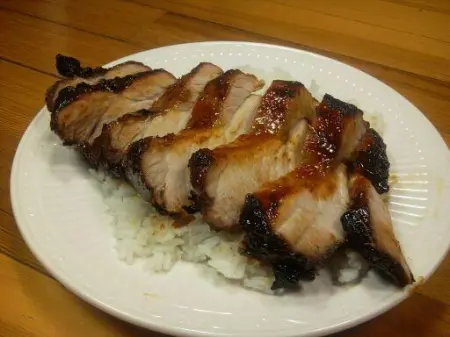Today was a great day, which I spent with my two sons at Central Park Zoo. Later was strolled around Central Park, fed Fritos to the fish in Bethesda’s fountain, and took a row boat ride on the lake. It was a full day and I was supposed make pepperoni pan pizza for dinner, but at the last minute I realized that my pantry didn’t have any crushed tomatoes to make the sauce. So it wasn’t until after the pizza dough had already risen that I decided to make this sauce-less Stromboli.
Seldom has a recipe gone so wrong as this Stromboli. The main culprit was the pizza dough, which was too thin and sticky to properly roll up into a stromboli. My nice tight roll loosened in the oven and ended up flat-like-a-pancake instead of round-like-a-submarine-sandwhich. Chris Kimball says that you can substitute any pizza dough, but the results were a disaster. You need the structure of the bread flour and the extra kneading. I give it 2-1/2 stars; edible but a big disappointment.
The silver lining from tonight’s dinner is that I learned a few lessons:
- Do not substitute another pizza dough. Use the recommended dough recipe, which I’ve given below (or Chris Kimball’s instructions are here). Regular pizza dough is too thin and does not hold together well as a roll. It allowed the roll to flatten out as it cooked and will result in disappointment.
- I did implement a few of my recommendations from last year. I used parchment paper instead of oiling the baking sheet. This was an improvement; however the bottom crust was still too tough after 50 minutes in a 400-degree oven. I believe the best solution will be to lower the temperature for the first 20 minutes to 350-degrees, then increase to 425-degrees to brown the rest of the crust, removing as soon as the crust reached your desired degree of doneness.
- Tenting (bending foil) as opposed to just covering with oiled-foil worked better. It’s so obvious that perhaps that’s what they meant to have said in the original recipe.
- I tried reducing reducing the exposed time (i.e. without being covered by foil) to between 15 and 20 minutes. In the end, Chris Kimball was right. 15-to-20 minutes is not enough. Watch it closely for the final 10 minutes and pull it out of the oven when ready.
- Finally, the recipe neglects to remind you to rotate half way through baking. Of course, it is also necessary in this recipe, but I forgot because it wasn’t mentioned. It resulted in uneven browning.
Rating: 2-1/2 stars.
Cost: $3.
How much work? Medium.
How big of a mess? Medium.
Start time 5:00 PM. Dinner time 7:30 PM.
The original recipe is here. The descriptions of the recommended dough (not the one I made tonight) is here and here.
Pizza Dough:
2 cups (11 ounces) bread flour
1-1/2 teaspoons Active Dry yeast
3/4 teaspoon salt
2 tablespoons olive oil
1 cup warm water
- I hydrated my teaspoon of Dry Active Yeast in 1 cup of 110-degree water for 10 minutes, a step that is not necessary for instant yeast.
- Combine 2-cups bread flour and 3/4 teaspoon salt in food processor fitted with dough blade.
- Add water/yeast mixture and 2 tablespoons olive oil with food processor running; mixing for 40 seconds.
- Let the dough rest for 2 minutes, then process again for another 30 seconds.
- Pour onto floured counter and knead by hand for 5 minutes.
- Place in a lightly oiled bowl and let rise for 1 hour in warm place, or until it has doubled in size.
- Gently punch down dough and turn out into an un-floured surface, reform into a ball, cover with plastic wrap and let rest for 20 minutes.
Pepperoni Stromboli:
4-oz thinly sliced deli pepperoni
6-oz mozzarella cheese
1 ounce Parmesan cheese
1 large egg
1 teaspoon sesame seeds
- Shredded mozzarella and grate Parmesan cheese. Line a rimmed baking sheet with parchment paper.
- Lightly flour a work surface, and roll the dough into a 12″x10″ rectangle, approximately 1/4″-thick.
- Evenly distribute the pepperoni and mozzarella over the dough, but leave a 1″ border along all four edges. Top with the grated Parmesan.
- Brush the edges of the dough with water so that the dough will properly seal. Start from a long side, roll the dough into a tight, 12″ cylinder, pressing the edges as you roll in order to seal.
- Pinch the seam closed and place on your parchment-lined baking sheet, seam side down. Cover with plastic wrap as you preheat the oven.
- Adjust oven rack to the middle position and preheat to 350-degrees.
- Remove the plastic wrap, lightly beat egg and brush over the top, and sprinkle with the sesame seeds.
- Tent with aluminum foil that has been sprayed lightly with non-stick cooking spray and bake for 25 minutes.
- Increase temperature to 425-degrees, remove foil, and bake until the crust is nicely golden, about 25 more minutes; rotating baking sheet after 10 minutes.
- Let cool on a wire rack for 5 minutes, then slice into 2-inch pieces for serving.
- Flat like a pancake












 Posted by My Year With Chris Kimball
Posted by My Year With Chris Kimball 






